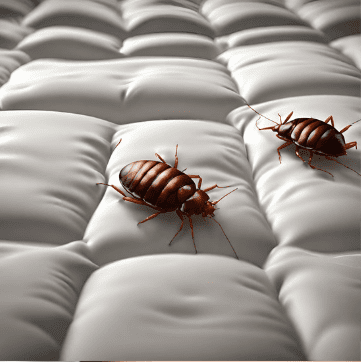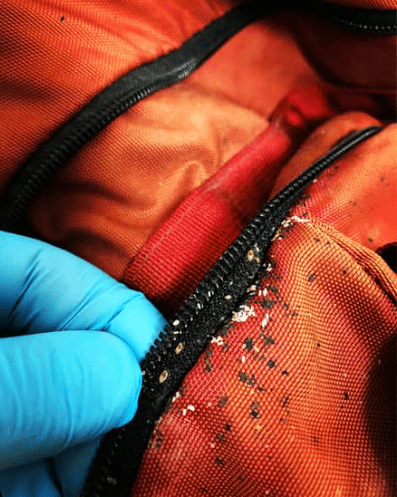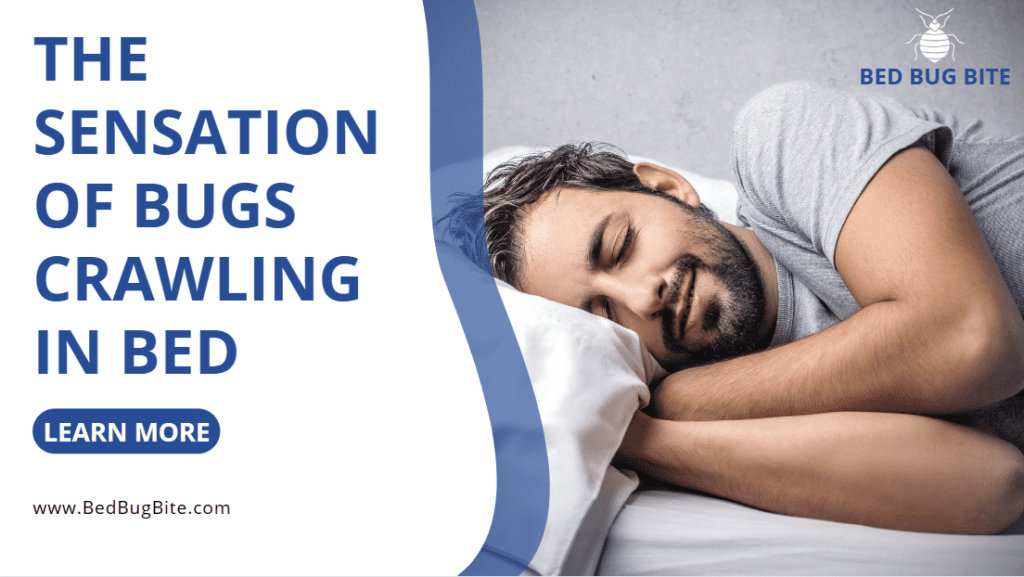Introduction:
Welcome to our comprehensive guide on understanding and addressing the unsettling sensation of feeling bugs crawling on you in bed. This unnerving experience, often occurring in the quiet of the night, can disrupt your peace and sleep quality. But what exactly triggers this sensation? Is it a mere figment of your imagination, or could it be an indication of a more tangible issue, like a bed bug infestation?
In this article, we delve deep into the causes behind this sensation, exploring both psychological and physical factors. For many, the immediate suspicion falls on bed bugs, notorious for their nocturnal activities and affinity for human hosts. These tiny, elusive pests can turn your sanctuary of sleep into a nightmare. We’ll guide you through the telltale signs of their presence, helping you discern if bed bugs are indeed the culprits.

However, it’s crucial to consider other potential causes as well. Sometimes, what feels like bugs crawling on your skin could be a manifestation of stress or anxiety. Known as formication, this phenomenon is a sensory hallucination where you feel like insects are crawling on or under your skin, even when there are none. This sensation is often linked to several medical conditions and psychological states. For a deeper understanding of formication and its causes, the Mayo Clinic offers a wealth of information on this subject.
As we move forward, we will not only identify the causes but also arm you with effective strategies to address this issue, ensuring a peaceful night’s sleep. Whether it’s a case of bed bugs or a psychological factor, our guide is here to provide you with the knowledge and tools to conquer this challenge. Let’s embark on this journey towards understanding and solving the mystery of the sensation of bugs crawling on you in bed. …Read more Bed Bug Content Here!
Unpacking the Causes: Is It Bed Bugs?
Embarking on our quest to understand the sensation of bugs crawling on you in bed, it’s essential to differentiate between psychological and physical causes. This distinction is crucial in determining the right course of action.
Differentiating between Psychological and Physical Causes
It’s important to recognize that not every sensation of bugs crawling on your skin is due to an actual infestation. Psychological factors, such as stress or certain mental health conditions, can create a sensation known as formication. On the other hand, physical causes are directly related to environmental factors, like the presence of bed bugs. Knowing the difference is key to addressing the issue correctly.
Signs of Bed Bug Presence in Your Bed
If physical causes are suspected, bed bugs are often the first culprits that come to mind. These tiny pests are experts at hiding, making them difficult to spot. However, there are several signs you can look for:
- Bite Marks: Bed bug bites are often in a line or cluster and can be very itchy.
- Blood Stains: Small blood spots on your sheets could be a sign of bed bugs.
- Fecal Spots: Tiny black or brown spots on bedding or mattresses are telltale signs of bed bug feces.
- Actual Bugs: Adult bed bugs are about the size of an apple seed and can sometimes be seen in mattress seams or box springs.
For more detailed information on identifying bed bugs, the United States Environmental Protection Agency (EPA) provides an extensive guide on bed bug identification.
In the following sections, we will delve deeper into understanding bed bugs and their behavior, equipping you with the knowledge to discern and address this common yet often misunderstood issue. By the end of this guide, you’ll be better prepared to identify and tackle the root cause of that unsettling sensation, whether it’s a bed bug infestation or a psychological factor. Let’s move forward with clarity and confidence!
Bed Bug Behavior: Why the Nighttime Activity?
As we delve into the realm of bed bug behavior, understanding their nocturnal habits becomes crucial in addressing the sensation of bugs crawling on you in bed. These elusive pests have distinct patterns and reasons for their nighttime activity, which is often when they are most problematic.
Explanation of Bed Bug Nocturnal Habits
Bed bugs are predominantly nocturnal creatures. They are drawn out by the carbon dioxide we exhale and the warmth of our bodies, making nighttime, when we are asleep and less likely to disrupt them, their prime feeding time. Their peak activity is usually an hour before dawn. This habit not only maximizes their feeding opportunity but also helps them avoid detection, as they can retreat to their hiding places by the time we wake up.
How Bed Bugs Detect Human Presence
Bed bugs have developed a sophisticated mechanism to locate their hosts. They possess sensors that can detect both the carbon dioxide exhaled by humans and the warmth of the body. These sensors guide them towards their food source even in complete darkness. This highly evolved detection system makes them efficient parasites, especially in environments where humans rest for long periods, like beds.
To gain a deeper understanding of bed bug behavior and their sensory capabilities, resources such as the National Pest Management Association provide comprehensive insights into these aspects.
The knowledge of bed bug behavior is not just academic; it’s a vital tool in our arsenal against them. By understanding their patterns, we can better strategize our approach to prevention and eradication. In the next sections, we will use this understanding to explore real-life experiences with bed bugs and effective prevention strategies. Stay tuned as we continue our journey towards a bed bug-free environment.
Personal Stories: Real Experiences with Bed Bugs
Moving forward in our comprehensive guide, we now turn to real-life experiences with bed bugs. These personal stories not only provide valuable insights but also help us understand the practical aspects of dealing with these pests.
Sharing Anecdotal Evidence from Extermination Work
Throughout my career as a bed bug exterminator, I’ve encountered numerous cases, each unique yet telling in its own way. One common theme in these encounters is the element of surprise—many homeowners are unaware of an infestation until it becomes severe. I recall a particular case where a family was baffled by mysterious bites for weeks before discovering bed bugs in an old recliner. This story highlights the importance of early detection and the often-overlooked places bed bugs can hide.

How These Experiences Shape Understanding of Bed Bug Behavior
Each extermination experience adds to a deeper understanding of bed bug behavior. For instance, I’ve learned that cluttered environments provide more hiding spots for bed bugs, making them harder to eradicate. Time and again, I’ve seen that regular inspection and maintenance are key to preventing infestations. These experiences have reinforced the importance of being vigilant and proactive in bed bug management.
Drawing from these personal stories and experiences, we gain not only empathy for those affected but also practical knowledge in combating bed bugs. The Bed Bug Foundation, an excellent resource, offers further insights and real-life case studies on bed bug management.
In the next section, we’ll leverage these insights to discuss prevention strategies. Understanding the nuances of bed bug behavior and learning from real-life scenarios are instrumental in devising effective methods to keep these pests at bay. Stay with us as we explore practical and effective prevention strategies.
Prevention Strategies: Keeping Bed Bugs at Bay
Equipped with knowledge and insights from real experiences, we now focus on prevention strategies to keep bed bugs at bay. Effective prevention is key to ensuring these pests don’t become unwelcome guests in your home.
Tips for Preventing Bed Bug Infestations
Prevention starts with awareness and vigilance. Here are some essential tips:
- Regular Inspections: Regularly check places where bed bugs are likely to hide, like mattress seams, bed frames, and furniture crevices.
- Travel Smart: When traveling, inspect hotel room beds and keep your luggage off the floor. Use luggage racks whenever possible.
- Reduce Clutter: Less clutter means fewer hiding places for bed bugs.
- Encase Mattresses and Pillows: Use protective covers to prevent bed bugs from infiltrating your bed.
- Be Cautious with Second-Hand Furniture: Inspect thoroughly for signs of bed bugs before bringing anything into your home.
Regular Maintenance and Cleanliness Routines
Maintaining a clean and orderly environment is crucial in preventing bed bug infestations:
- Vacuum Regularly: Regular vacuuming can help remove any bed bugs or eggs that may have found their way in.
- Wash Bedding Regularly: Wash and heat-dry your bed linens frequently to kill any bed bugs.
- Professional Inspections: Consider periodic professional inspections, especially if you live in a high-risk area.
The Centers for Disease Control and Prevention (CDC) offers additional guidelines on preventing bed bug infestations, emphasizing the importance of cleanliness and regular inspections.
As we move forward in our guide, we will explore what to do in the event of a suspected infestation. Prevention is powerful, but it’s equally important to be prepared with effective solutions should bed bugs still find a way into your home. Stay with us as we discuss the steps to take when you suspect an infestation, ensuring you’re fully equipped to tackle these challenges head-on.
Effective Solutions: When You Suspect an Infestation
Even with the best preventive measures, bed bug infestations can still occur. Recognizing the signs early and responding promptly is vital. In this section, we’ll guide you through the steps to effectively address a suspected bed bug infestation, whether you choose a professional approach or decide to tackle it yourself.
Step-by-Step Guide on Dealing with Suspected Bed Bug Infestations
When you suspect a bed bug infestation, acting quickly and methodically is key:
- Confirm the Infestation: Look for physical signs like live bed bugs, fecal spots, or shed skins.
- Containment: Try to contain the spread by vacuuming frequently and sealing off affected areas.
- Treatment: Depending on the severity, consider DIY treatments like heat or insecticide sprays, or call a professional exterminator.
- Follow-up: After treatment, continue to monitor for signs of bed bugs to ensure complete eradication.
Professional versus DIY Approaches
Choosing between a professional exterminator and a DIY approach depends on the infestation’s severity and your comfort level. Professionals bring expertise and specialized equipment, ensuring a thorough job. However, for smaller infestations, DIY methods can be effective. Whichever route you choose, it’s important to follow safety guidelines and use products specifically designed for bed bugs.
For comprehensive guidance on treatment options, the Environmental Protection Agency (EPA) provides a detailed overview of both professional and DIY bed bug control methods.
As we conclude this section, remember that dealing with a bed bug infestation requires patience and persistence. The next part of our guide will focus on ensuring long-term relief post-extermination, so you can rest assured that your living space remains bed bug-free. Stay tuned for more expert advice on maintaining a bed bug-free environment post-treatment.
Ensuring Long-Term Relief: Post-Extermination Care
After addressing a bed bug infestation, ensuring long-term relief is crucial. This phase is about being proactive to prevent re-infestation and maintaining a vigilant stance to safeguard your home. Let’s explore the measures necessary to keep your environment bed bug-free.
Measures to Prevent Re-Infestation
Following extermination, it’s important to stay proactive:
- Regular Inspections: Continue to inspect your home regularly, especially the previously infested areas.
- Maintain Cleanliness: Keep your living space clean and clutter-free to reduce hiding spots for any potential future bed bugs.
- Seal Entry Points: Check for and seal any cracks or crevices in walls, floors, and furniture where bed bugs could enter or hide.
- Monitor After Travel: After traveling, inspect your luggage and clothing to ensure you’re not accidentally bringing bed bugs back into your home.
Importance of Ongoing Vigilance and Maintenance
Continuous vigilance is key in preventing bed bug reinfestation:
- Use Bed Bug Monitors: Consider installing bed bug monitors around your bed and furniture to catch any new bed bugs.
- Educate Your Household: Make sure everyone in your home knows what to look for and how to maintain a bed bug-free environment.
- Seek Professional Advice as Needed: Don’t hesitate to consult with a pest control professional for advice or inspections, especially if you’ve had a severe infestation before.
The National Pest Management Association offers further guidance and tips on post-extermination care and long-term prevention strategies.
As we wrap up this section, it’s clear that the journey to a bed bug-free home doesn’t end with extermination. Continuous effort and awareness are essential. In the next and final section, we’ll conclude with some empowering thoughts and final advice to reinforce your defenses against bed bugs. Stay with us for these concluding insights that will solidify your stance in this ongoing battle against bed bugs.
Conclusion: Empowering Yourself Against Bed Bugs
As we conclude our comprehensive guide on addressing the sensation of bugs crawling on you in bed, it’s important to reflect on the journey we’ve taken together. From understanding the causes to implementing effective prevention and treatment strategies, we’ve covered a wide array of vital information. Our goal has been to empower you with the knowledge and tools necessary to tackle bed bug issues confidently.
Recap of Key Points
We began by distinguishing between psychological and physical causes of the crawling sensation, highlighting the importance of identifying bed bugs. We delved into their nocturnal behavior and how they detect humans. Personal stories and experiences then provided us with real-life insights. We discussed various prevention strategies, guiding you through the steps to take in case of an infestation, and emphasized the significance of post-extermination care for long-term relief.
Encouraging Proactive and Informed Actions
Armed with this information, you are now better equipped to proactively tackle and prevent bed bug issues. Remember, vigilance and regular maintenance are your best defenses against these pests. Don’t hesitate to seek professional help when needed, and keep educating yourself and those around you.
Final Thoughts: Emphasizing Expert Guidance and Support
For further reading and resources, websites like the Centers for Disease Control and Prevention (CDC) and the Environmental Protection Agency (EPA) offer extensive information on bed bugs. These resources can be invaluable in your ongoing efforts to maintain a bed bug-free environment.
In closing, remember that dealing with bed bugs is a challenge that many face, but with the right knowledge and actions, it’s a challenge that can be successfully overcome. Stay informed, stay vigilant, and know that you have the power to protect your home and peace of mind from these unwelcome guests.




